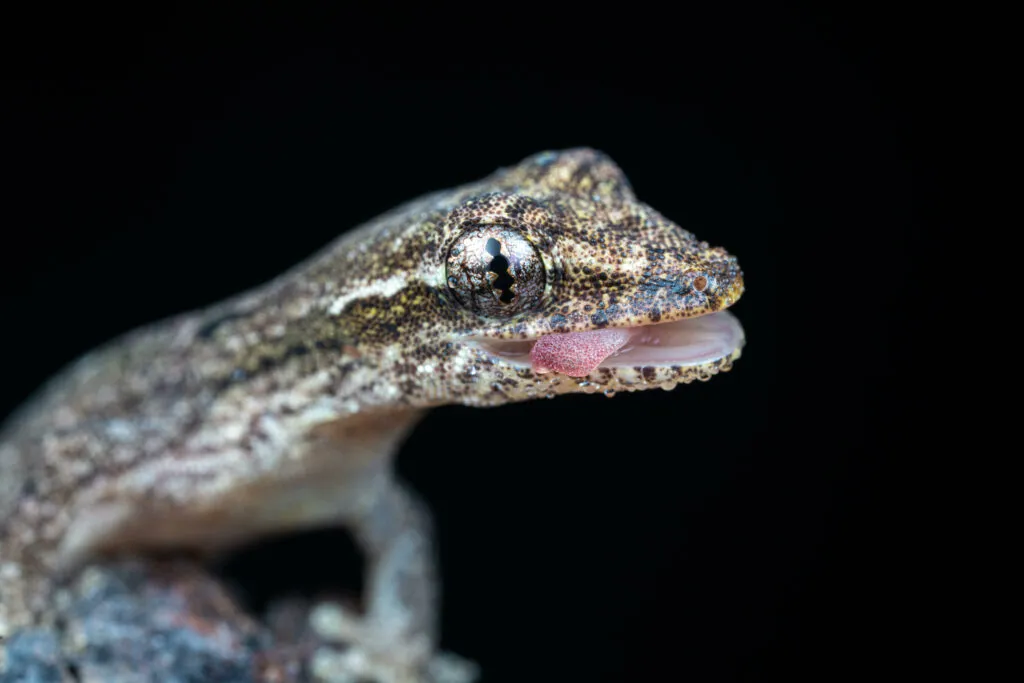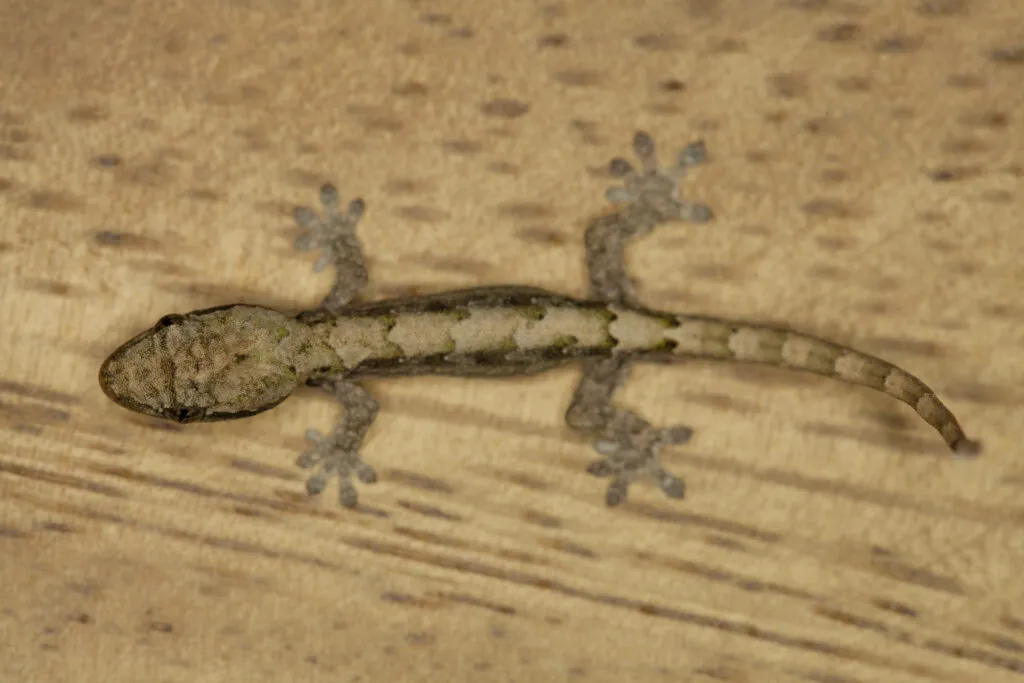
Mourning Geckos are parthenogenic (Lepidodactylus lugubris) are parthenogenic and can breed without much intervention from their owners. If you’re looking to add to your local Gecko population, our guide can help.
Mourning Geckos are typically females that have the ability to lay fertile eggs without fertilization by sperm. They can lay up to two eggs at 4-6 week intervals once they achieve sexual maturity at nine months. The eggs harden into the laying site and remain safe until the hatchlings emerge. The incubation period can last between 65 to 103 days.
Reptile owners searching for answers relating to Mourning Gecko reproduction can look to our seminal article for complete answers. We’ve included detailed answers regarding Mourning Gecko breeding, egg laying, and hatchling care!
Table of Contents
Mourning Gecko Breeding Specifics
There’s a lot that makes Mourning Geckos special. For instance, did you know all Mourning Geckos are females? Besides that, these frugivorous (animals that feed on fruits) reptiles are also parthenogenetic.
Why is that important regarding breeding? It’s simple. Parthenogenesis is an asexual reproductive strategy that allows the growth and development of embryos to occur without fertilization by sperm.
That means your Gecko can lay eggs and create miniature clones of itself without needing a male lizard for any type of fertilization. Here are some other pertinent facts relating to the species’ breeding routine.
How Do Mourning Geckos Breed?
Mourning Geckos are primarily females and can reproduce asexually. Female Mourning Geckos use a process known as pseudocopulation to produce viable eggs that do not need to be fertilized by the males.
In the wild, the female will often lay eggs in a covered, well-hidden, dark nook or cranny. The eggs are laid soft, but after a while, they quickly harden.
Young Mourning Geckos come out of their shelled homes when they’re ready to hatch as tiny replicas of their mothers who can hunt and look for
How Fast Do Mourning Geckos Reproduce?
Geckos are pretty popular as domestic pets for their sociability, little need for care, and capacity to reproduce rapidly. Each Mourning Gecko can lay one to two eggs in 4-6 week intervals.
After birth, the Mourning Gecko is well-equipped to take care of itself. The female Geckos generally do not stay around to take care of the eggs.
And, at about 8-10 months, the Mourning Gecko is mature enough to start reproducing independently.

Caring For A Gravid Mourning Gecko
Caring for a gravid Gecko is far easier than caring for many other species of reptiles. Reptile experts refer to females carrying eggs as gravid rather than pregnant as minimal embryonic development occurs in the female’s body.
The Mourning Gecko is generally low maintenance so long as you have the
If you need help with the diet and the
Avoiding Illnesses
Mourning Geckos are susceptible to respiratory infections, bacterial infections, and skeletal issues. Maintaining a steady temperature and appropriate humidity levels will save your Gecko from inflammations, pain, and discharge.
Frequent and proper cleaning of the terrarium will prevent bacteria from taking root in the
Additionally, providing calcium supplements will protect your pet from metabolic bone disease. But why is this a part of Gravid care?
Since Female Geckos are Parthenogeneic, any illness or disease they pick up while developing eggs carries the risk of transferring to the hatchlings. A healthy female Gecko means hardy hatchlings.
Mourning Gecko Egg Care And Specifics
Now that we’ve covered how to care for gravid Geckos, it’s time to explore what nurturing Gecko eggs involves. Here are some pertinent questions relating to the species’ eggs and incubation specifics.
How Long Does It Take For Mourning Geckos To Hatch?
It takes around 65 to 103 days for the eggs of the Mourning Gecko to hatch. No fertilization stage is involved as the species usually lay viable eggs. Sometimes, the female will lay an egg that brings about a male Mourning Gecko.
But as males are infertile, they play no part in the survival of their species from an evolutionary perspective.
That doesn’t mean male Geckos aren’t fun to adopt and care for. What’s more, the rarity of a male Gecko might even give you something to boast about in the reptile community.
Are All Mourning Gecko Eggs Fertile?
Without disease and sickness, proper care, and diet, it is unlikely that a Mourning Gecko will produce infertile eggs.
But, if the female Gecko suffers from a severe bacterial infection or skeletal disease, the chances of infertile eggs increase.
Moreover, when the hygiene of the terrarium isn’t up to par, the reproduction capacity of all females may be impacted. And sickness can also affect the capability of future Mourning Geckos to reproduce.
In most cases, the only time Gecko eggs are infertile is when the reptile is really old age or when it is starting to lay eggs for the first time.
Nurturing Mourning Gecko Eggs
Typically, female Geckos aren’t the maternal sort. When Mourning Geckos lay eggs, they secrete a glue-like substance that allows the eggs to be soft when laid and harden up soon after.
The substance solidifies and sticks to a spot where the eggs are laid to such a degree that many predators in the wild are discouraged from consuming them.
In captivity, however, things can be a little different. There are two differing opinions on how you can nurture Mourning Gecko eggs. Here’s what they are.
In-Vivarium Development
A few experts recommend in-vivarium development. That means leaving the eggs in the main
Once the female has laid the eggs, you have to be on the lookout only until the eggs harden, and once that process is complete, you will not have much to worry about.
However, once the eggs hatch, you will promptly have to remove the hatchlings to another
Relocation For Incubation
Some reptile sources suggest relocating the eggs to a separate
Since the eggs are glued, Gecko owners might have to cut through pieces of bamboo, PVC or small plastic tubes, or small cork rounds. The good news is that the eggs don’t require any special care or incubation.
Mourning Gecko Hatchling Care And Specifics

If you’re wondering what happens once the eggs are ready to hatch, this section is for you. Scroll on to learn the kind of care Gecko Hatchlings require.
How Big Are Hatchling Mourning Geckos?
Hatchlings of Mourning Geckos are pretty much the same as their mamas except for their body markings. Upon hatching, Gecko babies are about 1.5 inches long.
These are smaller Geckos growing up to only 3 inches long in total.
Do Mourning Geckos Eat Their Hatchlings?
Most geckos eat their hatchlings, and Mourning Geckos are no exception. However, because these reptiles are egg gluers, their eggs have a greater chance of survival.
Once the eggs have hatched, removing the juveniles from the adult
Nurturing Mourning Gecko Hatchlings
Much like Gecko adults, the hatchlings are easy to care for also. Mourning geckos are an arboreal species, meaning your
Tank Setup
Hatchlings should be placed in a
It is advised to keep hatchlings of the same size in a single
Also, hatchlings require misting several times a day and greater humidity levels so that their skin doesn’t dry out.
Diet
Hatchlings do not eat for the first two or three days. They receive nutrition from the yolk still in their bellies when they hatch.
And once the hatchlings have completed their first shed and pooped, they go around looking for
In the first week or so, hatchlings don’t eat too much. Keeping a shallow water bowl and providing tiny live feeders will go a long way in helping the hatchlings grow.
And it is usually after the first two weeks that hatchlings increase their
- Enchi Ball Python: A Unique and Stunning Morph of Python regius - March 27, 2025
- Emerald Tree Monitor: The Enigmatic Green Guardian of the Rainforest - March 26, 2025
- The Egyptian Cobra (Naja haje): A Fascinating Serpent - March 25, 2025
